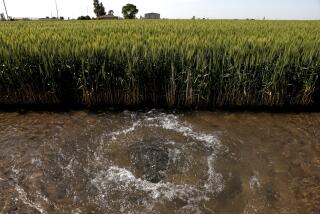Three years later, supervisors may revisit plan to raise funds for stormwater projects

A Caltrans worker toils to clear drains on flooded Interstate 5 in Sun Valley in January.
- Share via
Three years ago, an attempt to raise money for regional projects to capture and treat stormwater went nowhere.
Homeowners, businesses and school districts opposed the proposed parcel fee, and Los Angeles County supervisors killed a proposed initiative before it could go to voters in a countywide mail-only ballot for property owners.
Now, with heightened attention on water supplies and flood control as a result of the drought and El Niño, some local officials and activists want to try again.
Environmentalists and public officials have talked about trying another countywide ballot measure next year to pay for stormwater capture infrastructure, county Supervisor Sheila Kuehl said. “The county just doesn’t have enough money in its coffers to do all the work that’s necessary. We will need, I think, to go to the public for it,” she said.
In the Los Angeles River watershed, only about 15% of stormwater is captured, cleaned up and placed back in the water supply. The rest goes into the ocean, a loss of millions of gallons each year.
Stormwater management plans developed by the county and cities in the Los Angeles area in response to new permitting requirements add up to an estimated $20 billion over the next 20 years.
At the time of the previous proposed initiative, those plans did not yet exist. The annual parcel fee would have ranged from $54 for an average single-family home to thousands of dollars for large commercial properties, raising about $290 million annually.
At a meeting last month, county supervisors — including Michael D. Antonovich, who adamantly opposed the previous proposed parcel fee — expressed chagrin at the amount of water lost in the first storm of the season. “This is a very serious problem,” Antonovich said. “We are now in a drought, and we continue to allow water to go to the ocean.”
Tony Bell, a spokesman for Antonovich, said he opposes “unfunded mandates from the state and feds” to meet clean water standards and opposed the previous measure because it “had no local support — nor did it identify projects” and still fell short of raising the money needed to meet clean water mandates.
But Bell said the supervisor “may be open to a targeted, equitable, bottom-up proposal that has local support” from cities, businesses and community groups.
Supervisor Hilda Solis said she was interested in exploring a funding measure. Los Angeles Mayor Eric Garcetti’s spokeswoman, Connie Llanos, also signaled interest.
“Mayor Garcetti knows we need to reduce our dependence on imported water, expand our local supplies and capture more stormwater,” she said in a statement. “We look forward to continuing our discussions and evaluating options in the coming months.”
The last attempt at a stormwater funding measure came under fire because it contained no end date or list of specific projects. In addition, school districts complained that it would cut into already tight budgets, and some property owners were upset because the hearing notice and protest form for the proposed measure looked like junk mail and they threw them away.
Some of the groups that objected said they still have concerns.
“The previous stormwater proposal was flawed in both its structure, lack of transparency and accountability, as well as a voting process that did not ensure educated voters making an informed decision,” said Ruben Gonzalez, senior advisor on strategic affairs for the Los Angeles Area Chamber of Commerce. Next time, he said, the business community “would expect a robust process of communication with all stakeholders before any final proposal was put to the voters.”
Shannon Haber, a spokeswoman for Los Angeles Unified School District, said in a statement that the district “has made significant water quality infrastructure improvements as part of its bond-funded new school construction effort” but faces a structural budget deficit that “threatens our long-term financial viability.”
Even without a dedicated funding source, county officials said they’ve made progress on capturing stormwater.
The county’s flood control district runs 27 spreading grounds where stormwater, recycled and imported water seeps into underground aquifers, and close to 100,000 catch basins that feed into a 3,300-mile network of underground storm drains.
In an average year, 200,000 acre-feet of water — enough for about 1.6 million people — gets cleaned up and placed back in the water table throughout the county, said Gary Hildebrand, a deputy director with the county’s Department of Public Works who manages flood control. In the San Gabriel Valley, where porous soil makes it easier to filter water into the aquifer, about 90% of the storm runoff gets captured.
The county and cities have completed some ambitious projects — such as a park in a flood-prone area of Sun Valley where storm drains route runoff into a filtration system underneath a soccer field. Across the street, county officials plan to turn a former gravel pit into a wetlands park that will feed water into the filtration system and then into the water table.
The wetlands project will cost an estimated $52 million, split between the county and city.
Andy Lipkis, president of TreePeople, a nonprofit organization that works on clean water projects, including the one in Sun Valley, said finding money for each project without a regional funding source is difficult.
“The way we’re having to go about it all now is like a bake sale every time,” he said.
Twitter: @sewella
More to Read
Sign up for Essential California
The most important California stories and recommendations in your inbox every morning.
You may occasionally receive promotional content from the Los Angeles Times.











